This Miso Salmon is marinated in a sweet and savory miso sauce and broiled until the outside is beautifully crisp and the inside is perfectly moist. It’s even better when you serve the fish with Japanese ginger rice. You‘ll make it a staple in no time.
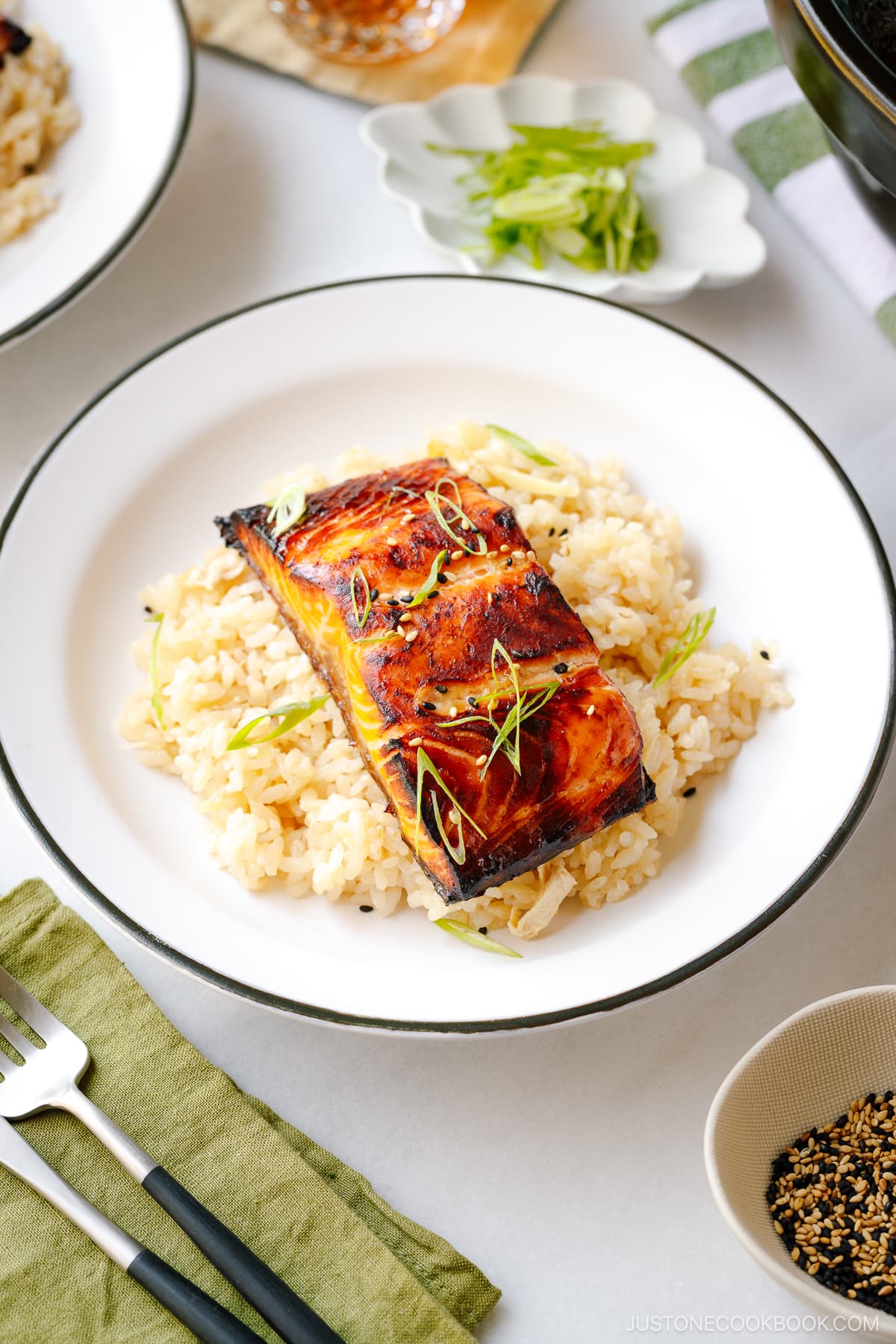
Salmon is truly one of the best choices of fish out there! I love that the fish is readily available, extremely versatile, and makes a healthy protein for any meal. Today, I’m going to share my tried-and-true easy salmon recipe—Miso Salmon (味噌サーモン).
Here, salmon fillets are marinated in a mixture of miso, sake, mirin, soy sauce, and sesame oil, and then broiled until they become succulent and golden brown. You and your family will love how simple and satisfying it is, especially when served with rice and vegetables.
Table of Contents
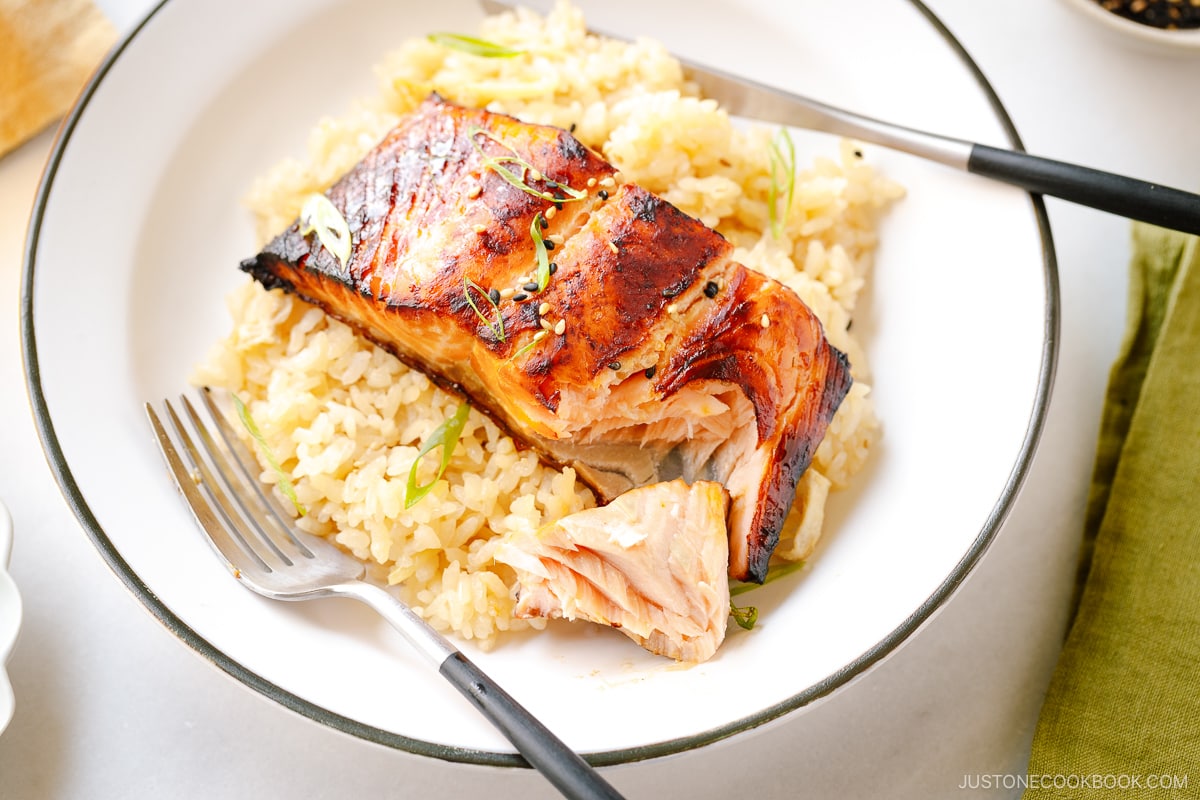
Using Miso in Japanese Recipes
Miso (味噌) is a Japanese condiment primarily made from fermenting soybeans, salt, koji (a fermentation starter), and sometimes rice or barley.
New to miso? Read this post.
From miso soup to salad dressing and miso marinated fish, miso is a common condiment used every day in Japanese kitchens. Its sweet and salty flavor makes it a wonderful marinade, particularly well-suited for fatty fish like cod and salmon.
I have previously shared the Miso Black Cod recipe made popular by Nobu on the blog. In today’s recipe, we’ll learn the best way to apply the miso treatment to salmon and how to achieve flavorful, tender fish with a golden top that everyone will enjoy.
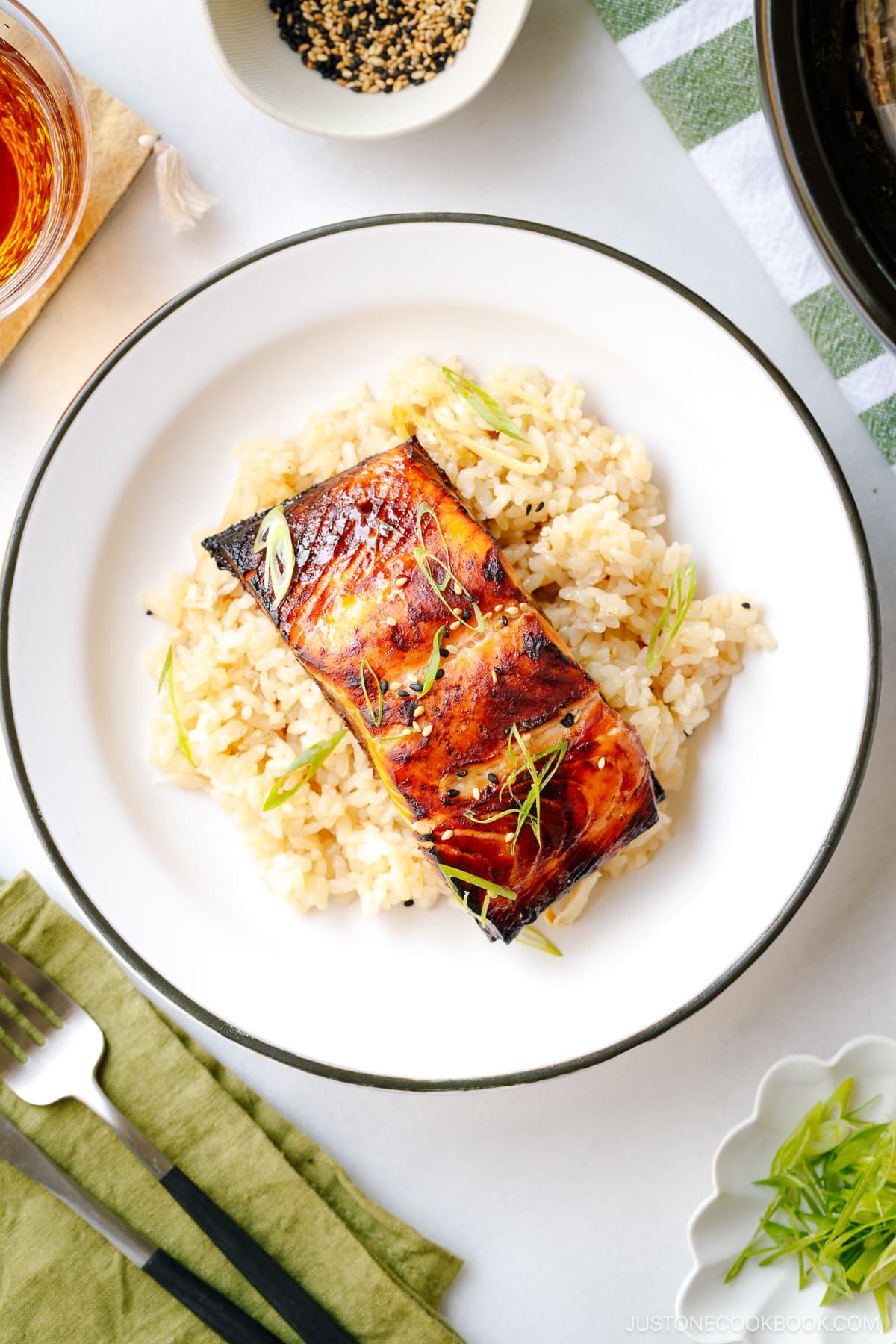
How to Make Miso Salmon
The Ingredients You’ll Need
- Salmon: I recommend using salmon that is less than 1 inch (2.5 cm) thick for broiling. If you don’t have a broiler, wild King/Chinook salmon, which is thick and has a high-fat content, is ideal for baking. You don’t have to worry about the fish drying out quickly. Farmed Atlantic salmon, while very rare to find in the wild, is a more affordable and accessible option.
- Miso: I use white miso (shiro miso) in this recipe for two reasons. First, it is widely available in Japanese and Asian markets, as well as mainstream grocery stores. Second, the flavor profile complements this recipe well. If you have other types of miso, you can certainly use them (I use various miso for this recipe as well). Just remember that each brand and type of miso has a different level of saltiness, so adjust the amount accordingly.
- Soy sauce: I use organic kikkoman soy sauce. Please note that Chinese and Korean soy sauces have slightly different tastes.If you plan to cook more Japanese food, consider getting Japanese soy sauce.
- Sake: I use a $5-8 drinking sake and do not use a cooking sake that contains other ingredients, like salt. Sake is an important ingredient in Japanese cooking (read why it’s important here). If you don’t have it at the moment, use Chinese rice wine or dry sherry.
- Mirin: Just like sake, mirin is another important condiment for Japanese cooking. More about it in this post.
- Roasted sesame oil: We just need a tiny bit for the aroma.
- Garnish: Toasted black and white sesame seeds, and chopped green onion.
The Cooking Steps
- Make the miso marinade and marinate the salmon for 1-2 hours.
- Remove the marinade from the salmon and broil it.
- Serve and enjoy!
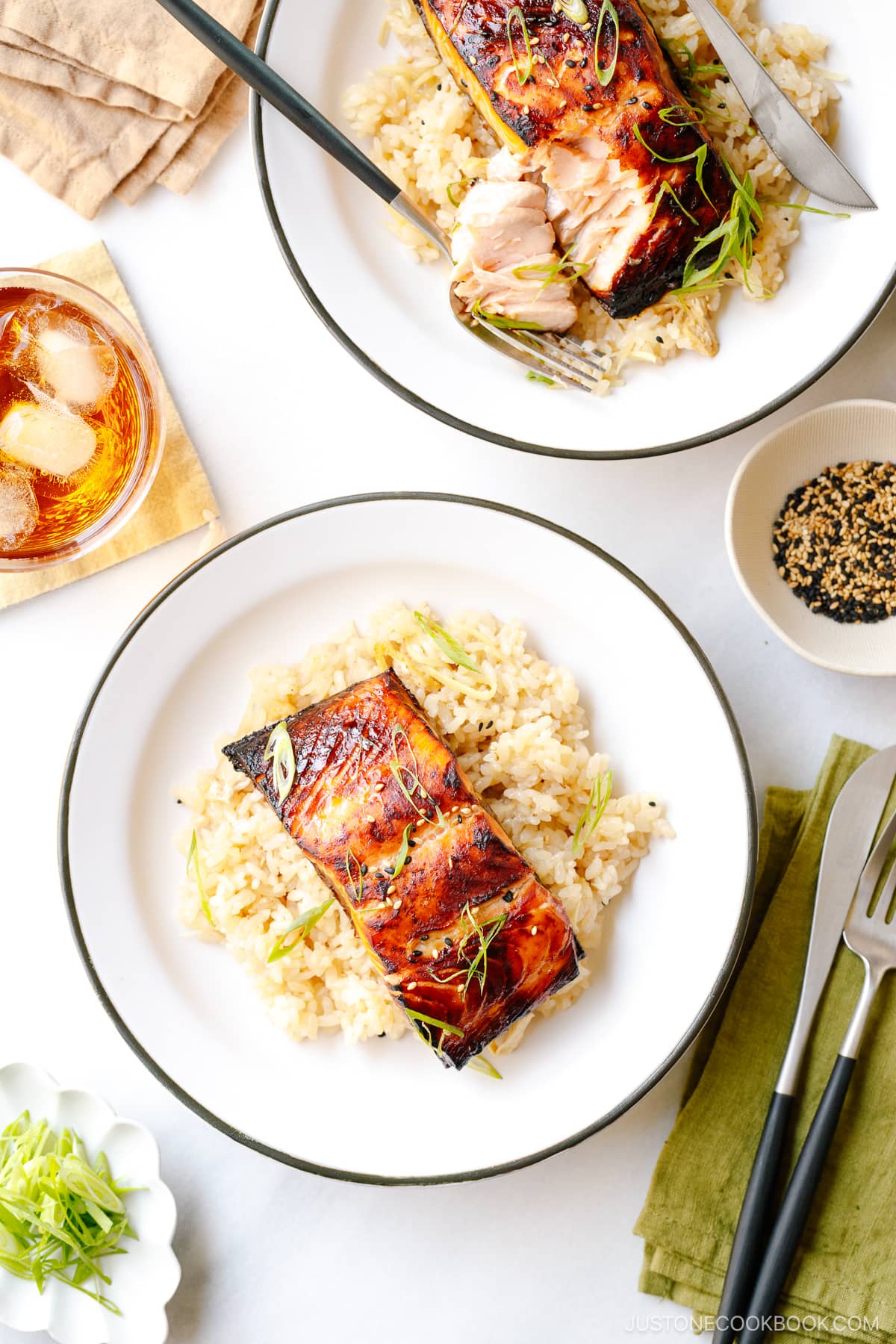
How to Prep the Miso Salmon
It’s a very easy recipe, but make sure to read the following tips to make Miso Salmon successfully on the first try!
- Use skin-on salmon. Don’t remove the skin. It will prevent the flesh from overcooking and drying out. You don’t have to eat it, but keep it on!
- Remove small bones and scales from the skin before marinating. This would make your dinner more enjoyable, especially when you serve it to young children or to your dinner guests.
- Cut the salmon into individual fillets. Smaller fillets marinate and cook quickly!
- Marinade for 1-2 hours. For a salmon fillet less than 1 inch (2.5 cm) thick, you can marinate for up to 2 hours. For thick salmon, you can marinate for up to 3 hours. I don’t recommend marinating overnight because miso is quite salty.
- Remove the miso marinade completely. When cooking miso-marinated food, regardless if it’s fish or meat, you must remove the marinade completely because miso burns very easily. Plenty of flavors have been already absorbed into the salmon. If you still want a nice glaze, cook the remaining marinade with water over the stove and drizzle the sauce over the cooked salmon.
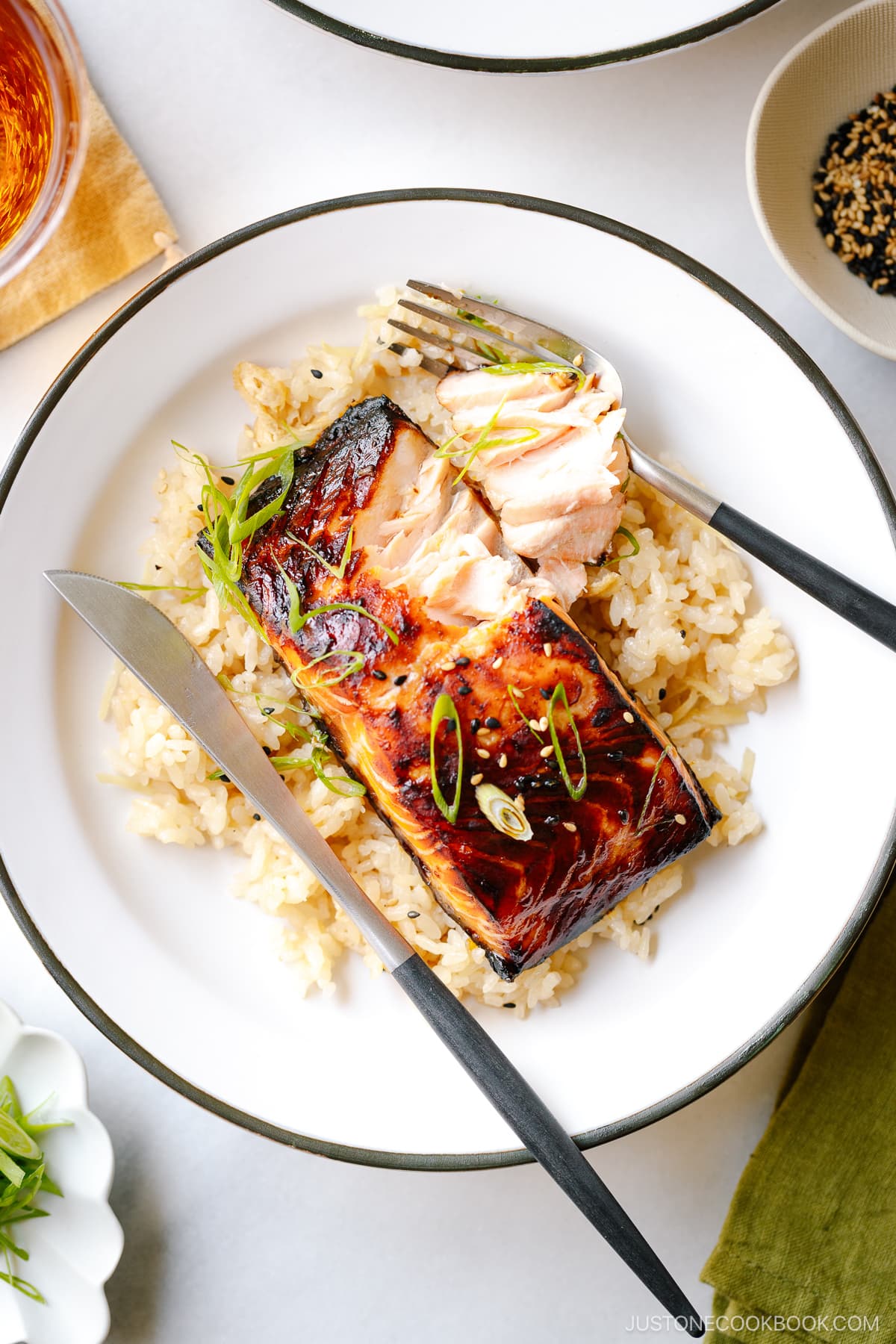
Broiling Tips
If you’ve been baking salmon all this time, I highly recommend trying the broiling method.
When you broil fish, the infrared energy from the heating element cooks the fish. Broiling is a much faster cooking method, resulting in beautifully browned fish that stays juicy and never dries out!
However, it’s important to exercise caution when broiling, as the miso, fresh herbs, and other garnishes are prone to burning. Keep a close eye on the food to prevent burning.
- Use a heavy baking sheet lined with aluminum foil. Avoid using parchment paper, as it can burn under the broiler. I recommend brushing or spraying oil on the foil to prevent the skin from sticking after the salmon is done cooking. You can then use a metal spatula to separate the skin from the foil. Once cooked, the salmon’s flesh can be easily separated from the skin by gently nudging and scooping it up with a spatula.
- Set the oven rack placed in the center position, 9 inches (23 cm) away from the top heating element.
- Set the broiler to high (550ºF/288ºC). My current oven comes with 3 settings (low, medium, and high), but my previous oven did not have a medium setting. Since each oven is different, make sure to control the heat by adjusting the distance of the rack. If you’re new to broiling, you might want to start with a medium setting or keep more distance from the heating element and gradually cook.
- Adjust the cooking by controlling the distance between the broiler and the surface of the food. Unlike baking, you don’t control the temperature in the oven. Broiling is similar to using hotter and cooler zones on your grill.
- Test if the salmon is cooking by flaking the flesh. If it flakes easily, it’s cooked through.
🙋🏻♀️ If your oven doesn’t come with a broiler setting, I included the baking method in the recipe card.
How Long Do You Broil Salmon?
Please remember that the broiling time depends entirely on your broiler’s settings, the distance of the rack from the heating element, and the thickness of the salmon fillets.
When I buy salmon fillets, I always opt for skin-on, center-cut fillets that are less than 1 inch (2.5 cm) thick. And make sure all the fillets are of the same thickness, each weighing roughly 6 ounces (170 g). After marinating the salmon in the refrigerator, it takes 10-13 minutes to broil.
How Do You Know When Salmon is Done?
You can tell when salmon is cooked when the flesh of the salmon goes from translucent to opaque, and the salmon flakes easily with a fork, chopsticks, or by pressing on the fish.
If the fish looks dry, you’ve probably cooked it a bit too long. When salmon is overcooked, you may notice white protein (known as albumin) coming out from the fish. While you can’t undo it, the salmon is still edible, albeit a little dry.
Useful Kitchen Tools
The best method is to use a meat probe thermometer (that comes with your oven) or an instant-read thermometer, especially when the salmon fillets are very thick. With the right tool, you don’t need to guess if the salmon is cooked to the right temperature: It’s perfect every single time.
- A probe thermometer allows you to track the temperature of your chicken, turkey, salmon, etc. in the oven as they cook so you don’t have to repeatedly open the oven door to test.
- An instant-read thermometer is a lot more versatile. You can check the temperature of your deep-frying oil and pan-fried fish or steak.

Frequently Asked Questions
Q: Wait, you said to cook the salmon until an internal temperature of 125-130°F (52-54ºC). I thought we had to cook it to 145°F (63ºC).
The USDA recommends cooking fish to an internal temperature of 145°F (63ºC); however, the remaining heat will continue to cook the salmon, resulting in well-overcooked fish. There are many discussions online on this topic, and many reputable cooking websites do recommend cooking the salmon to 120-130ºF (49-54ºC).
Q: Can I marinate the salmon overnight?
Miso is quite salty, so I don’t recommend marinating the salmon overnight, especially if the fillet is thin. Also, to marinate the salmon evenly, I recommend cutting a one-pound salmon fillet into two to four pieces. One to two hours is my recommendation. If you feel it’s not flavorful enough, please adjust it to your liking.
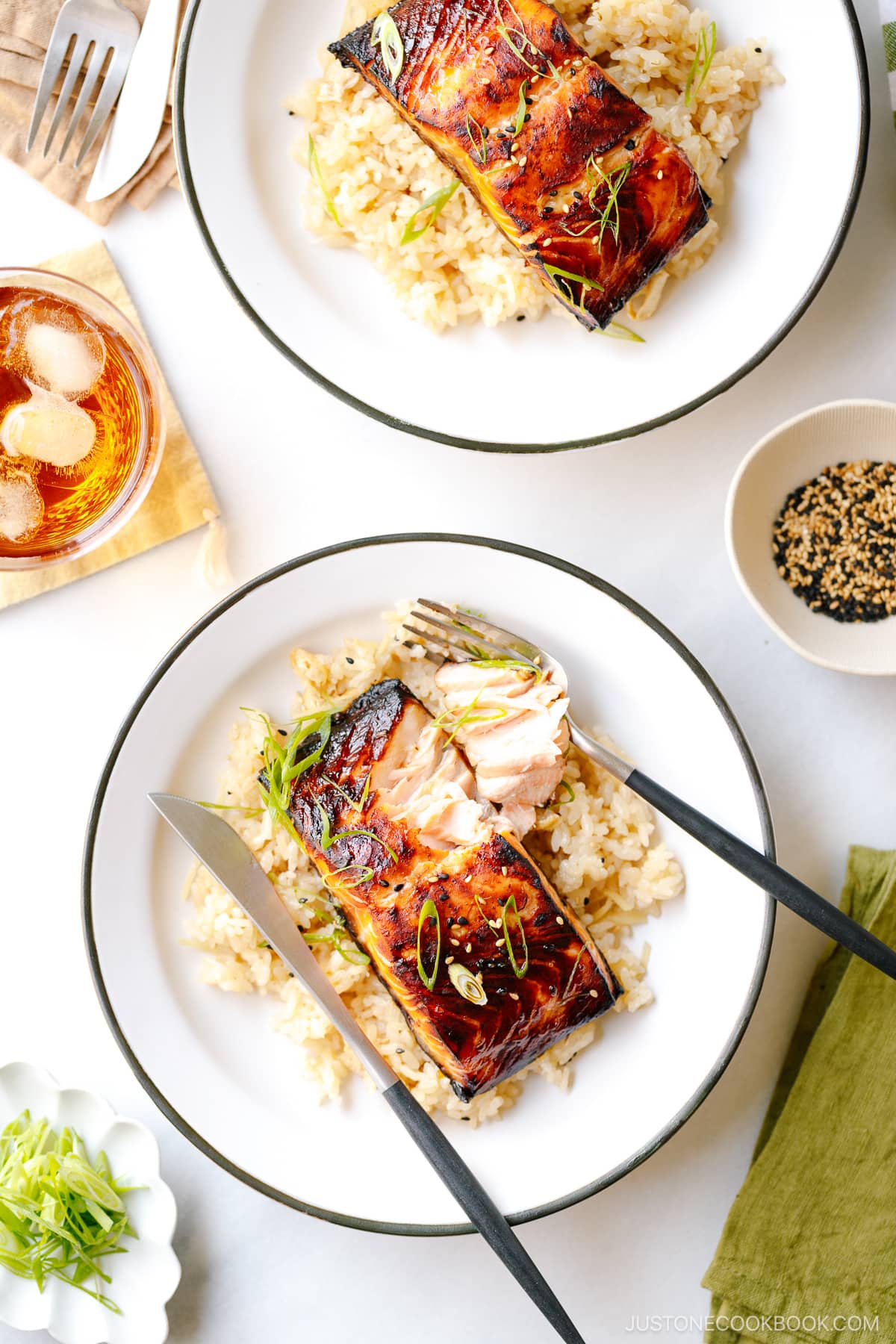
Bake vs. Broil Methods
In case you’re curious, I summarized the differences between broiling and baking fish, and which type of fish is suitable for broiling or baking for your future reference.
Broiling Method
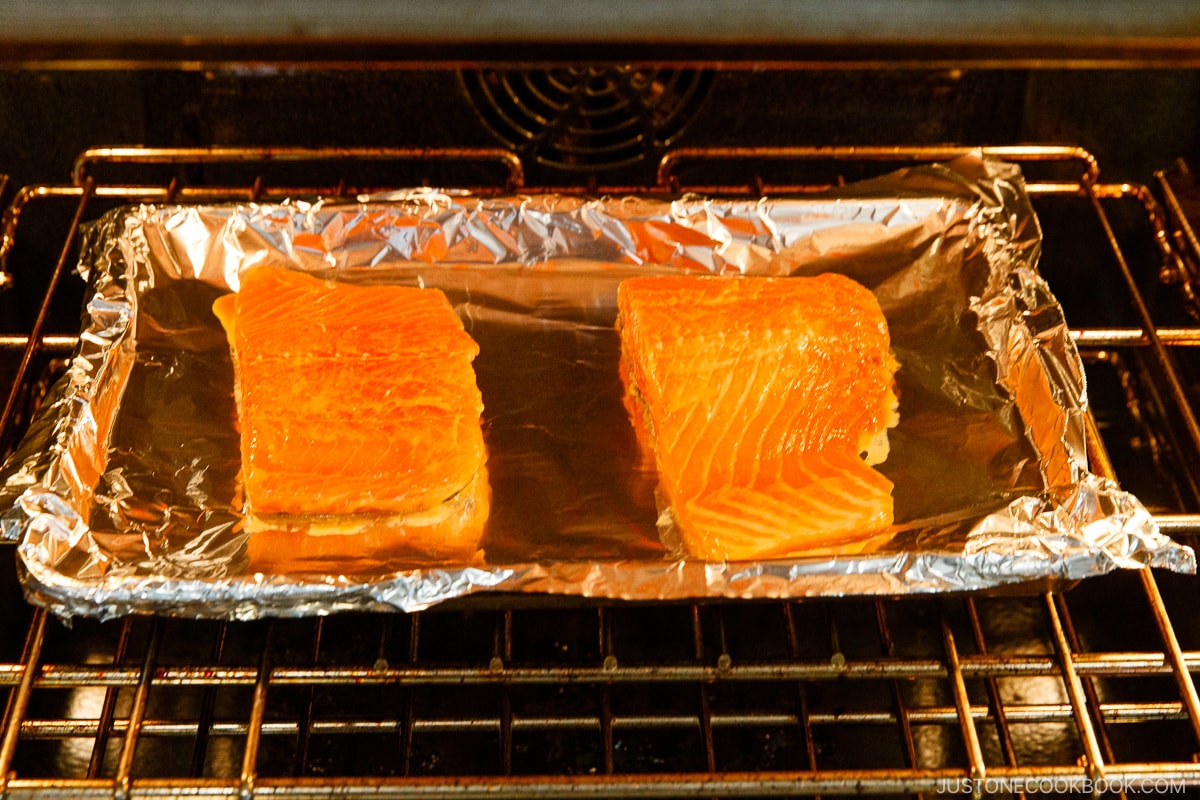
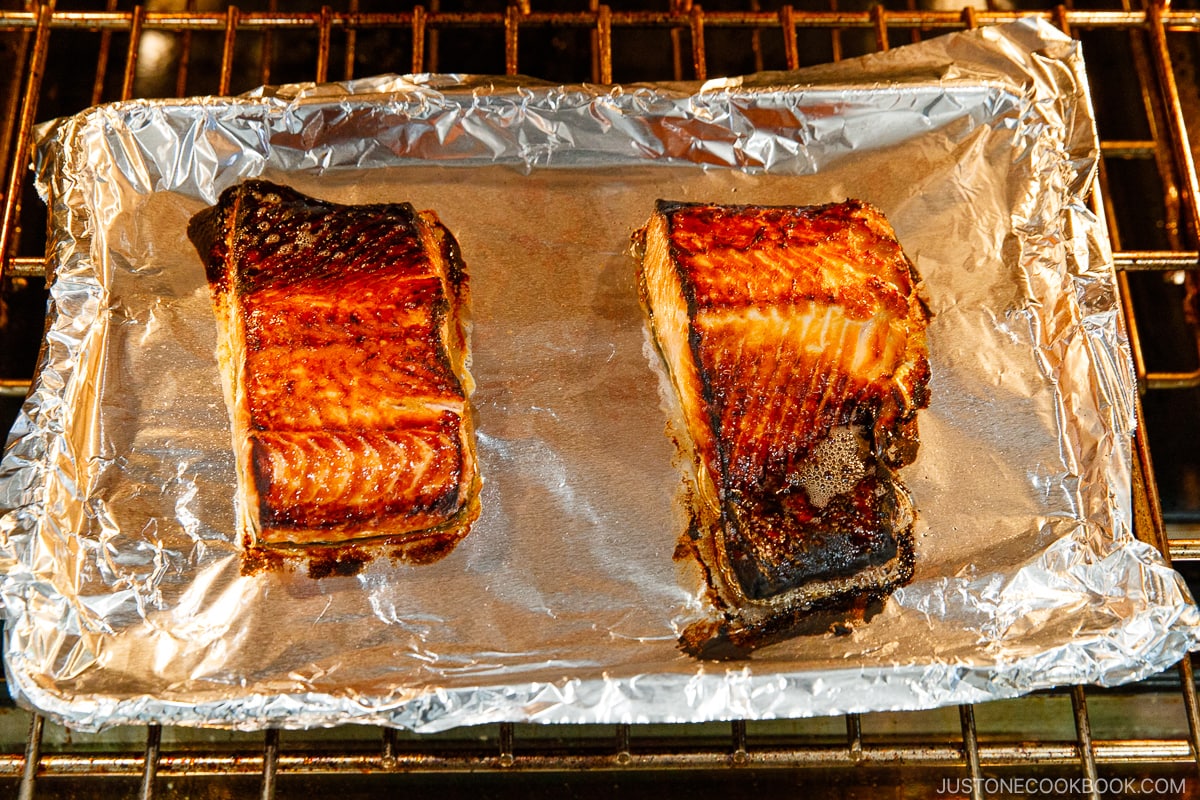
When you broil fish, the infrared energy from the heating element cooks the fish. You don’t control the temperature in the oven; instead, you control the distance between the broiler and the surface of the food.
Fish suitable for broiling:
- Fatty fish—salmon (thin-cut; under 1 inch or 2.5 cm), mackerel, and swordfish
- Moderately lean fish—cod, haddock (should be brushed with oil before broiled)
- Thin fish fillet—Japanese fish cut is often very thin (sold at Japanese supermarkets)
Baking Method
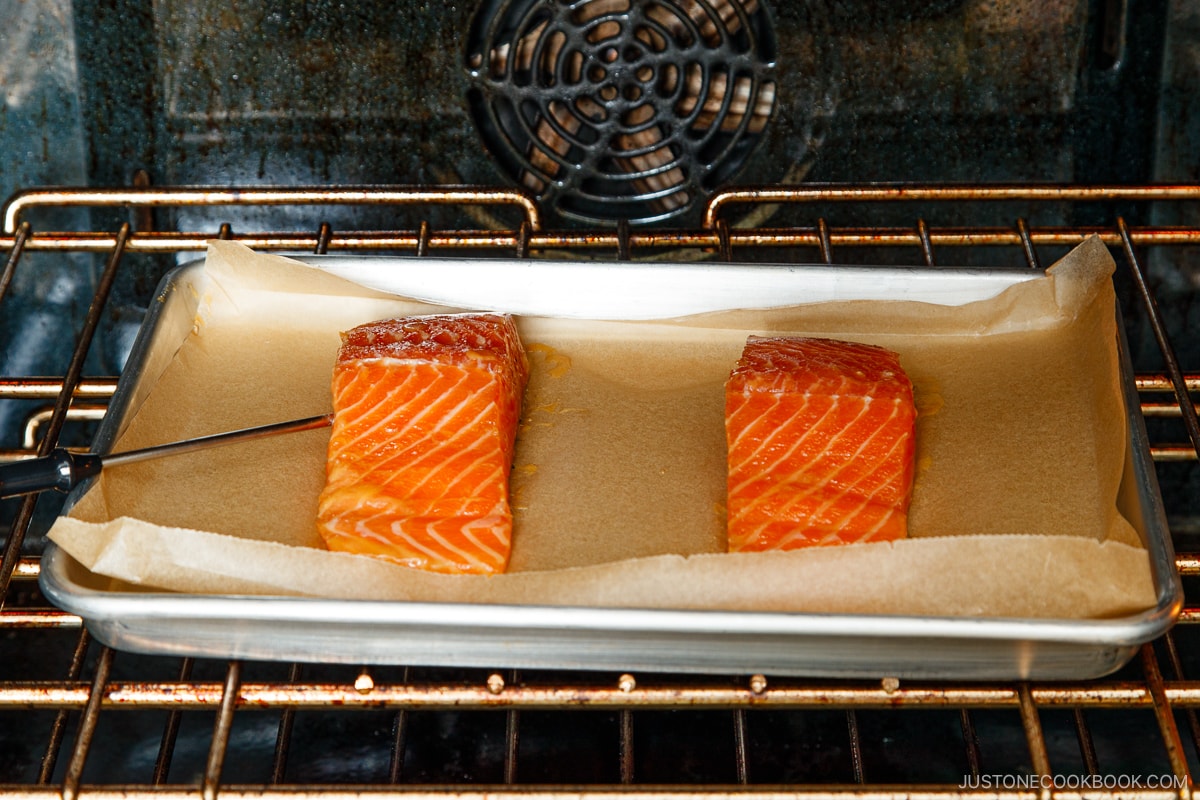
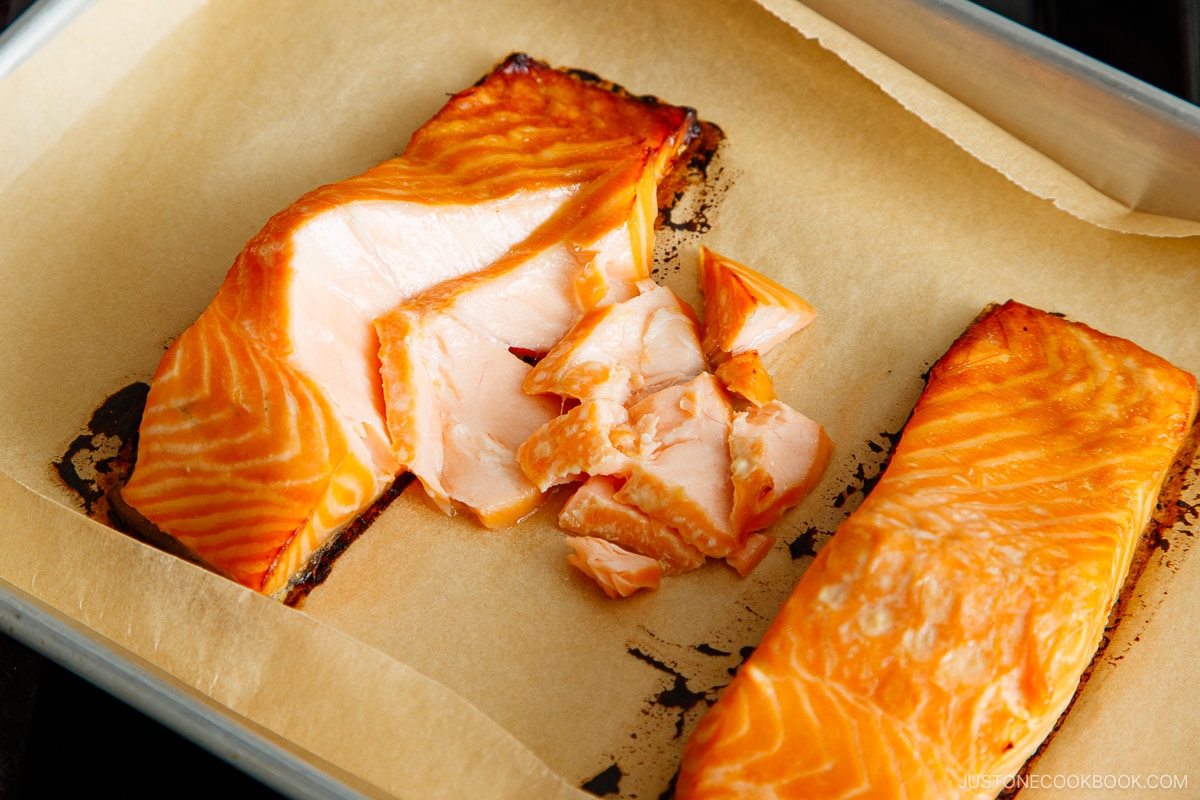
When you bake fish, hot air cooks the fish. The heat is carried through your oven by slow-moving natural currents of hot air, which is why baking takes a relatively long time and makes the fish surface a bit dry (see the image above). But it is more hands-off as you do not need to pay attention constantly.
Fish suitable for baking:
- Fatty fish—salmon (thick and fatty cut), mackerel, and swordfish
- Whole fish
- Thick and large fish fillets
- Lean and fragile fish—sole
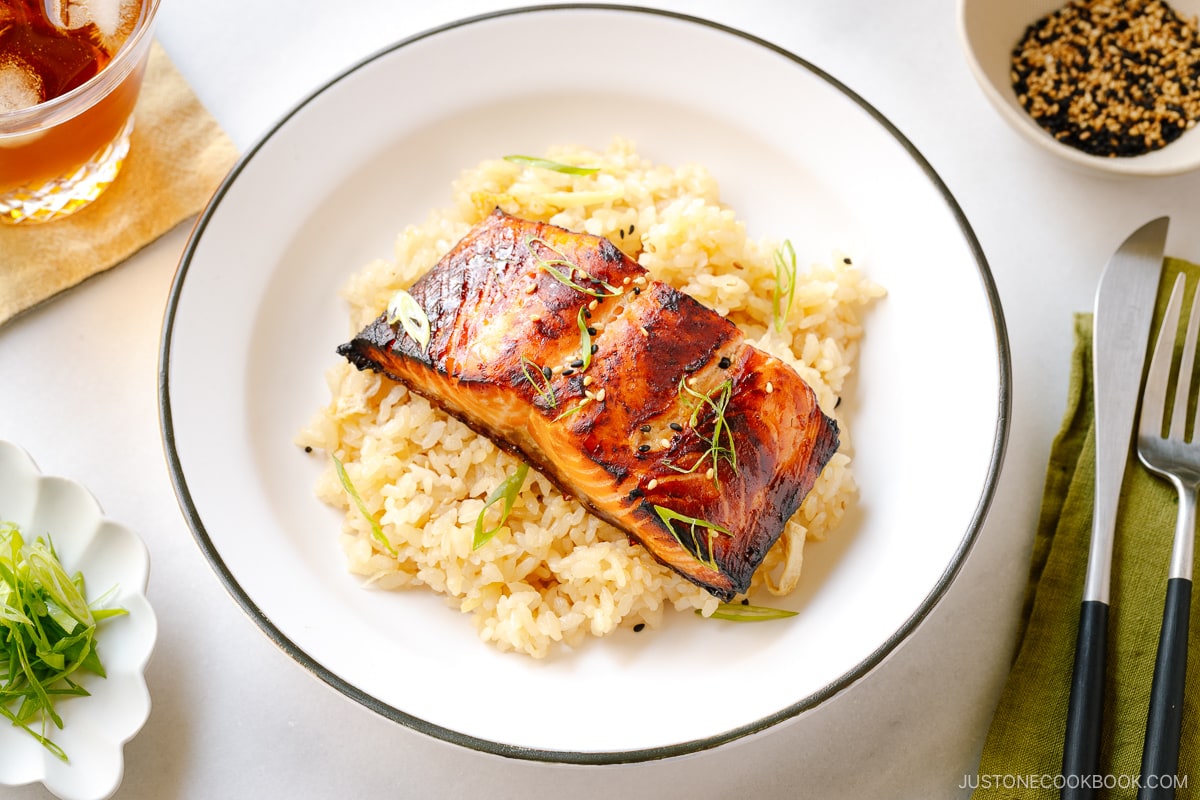
What to Serve with Miso Salmon
For a hearty yet wholesome family dinner, I enjoy serving Miso Salmon with Ginger Rice. The rich flavor of miso-marinated salmon is lovely when matched with the aromatic ginger-infused rice.
Here are other delicious side dishes that you can serve with Miso Salmon.
- Rice: Ginger Rice
- Soup: Kakitamajiru (Japanese Egg Drop Soup)
- Sides: Spicy Japanese Pickled Cucumber and Kinpira Gobo
- Salads: Spinach Gomaae (Japanese Spinach Salad) and Tofu Salad with Sesame Ponzu Dressing
Other Delicious Salmon Recipes
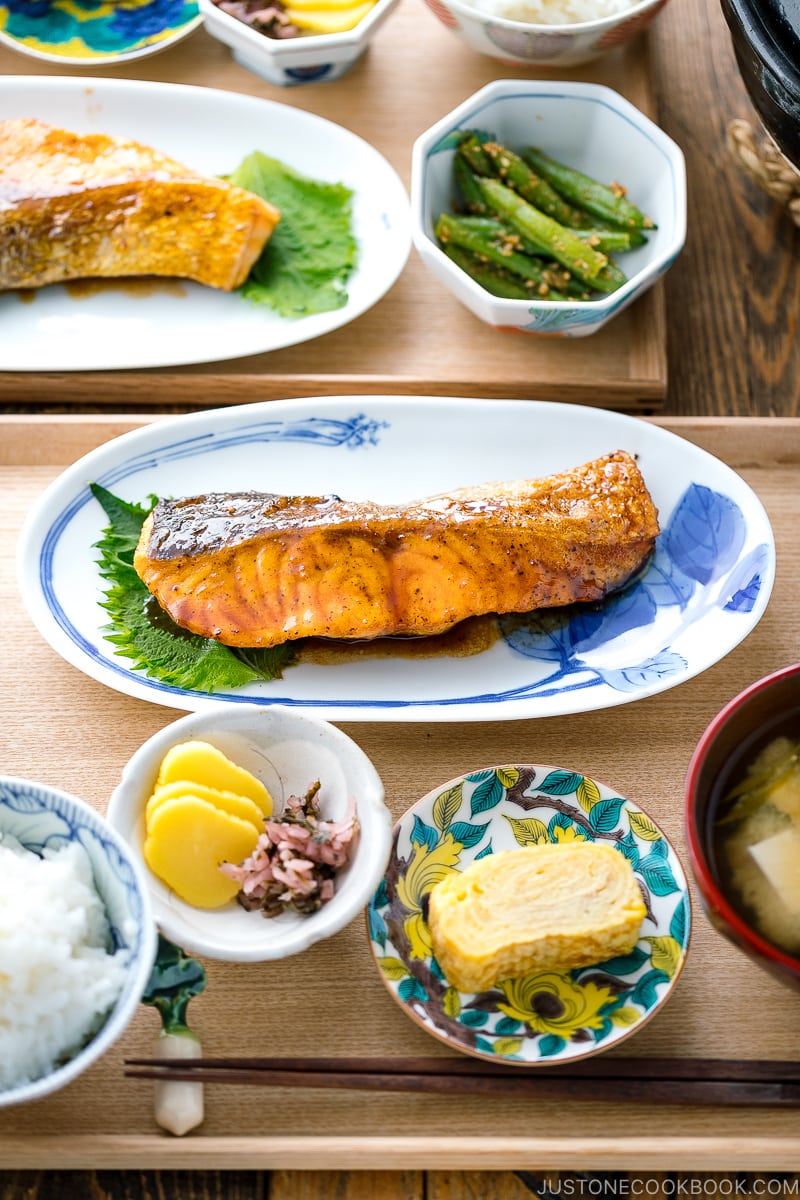
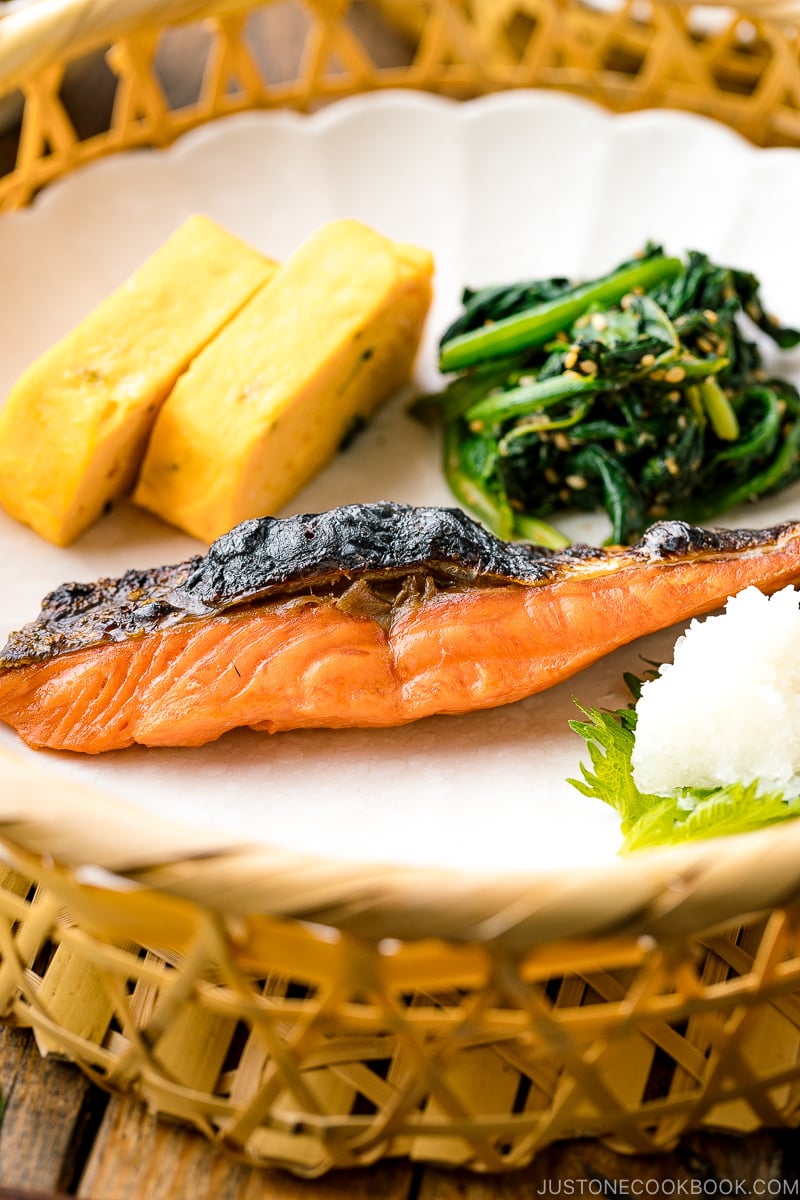
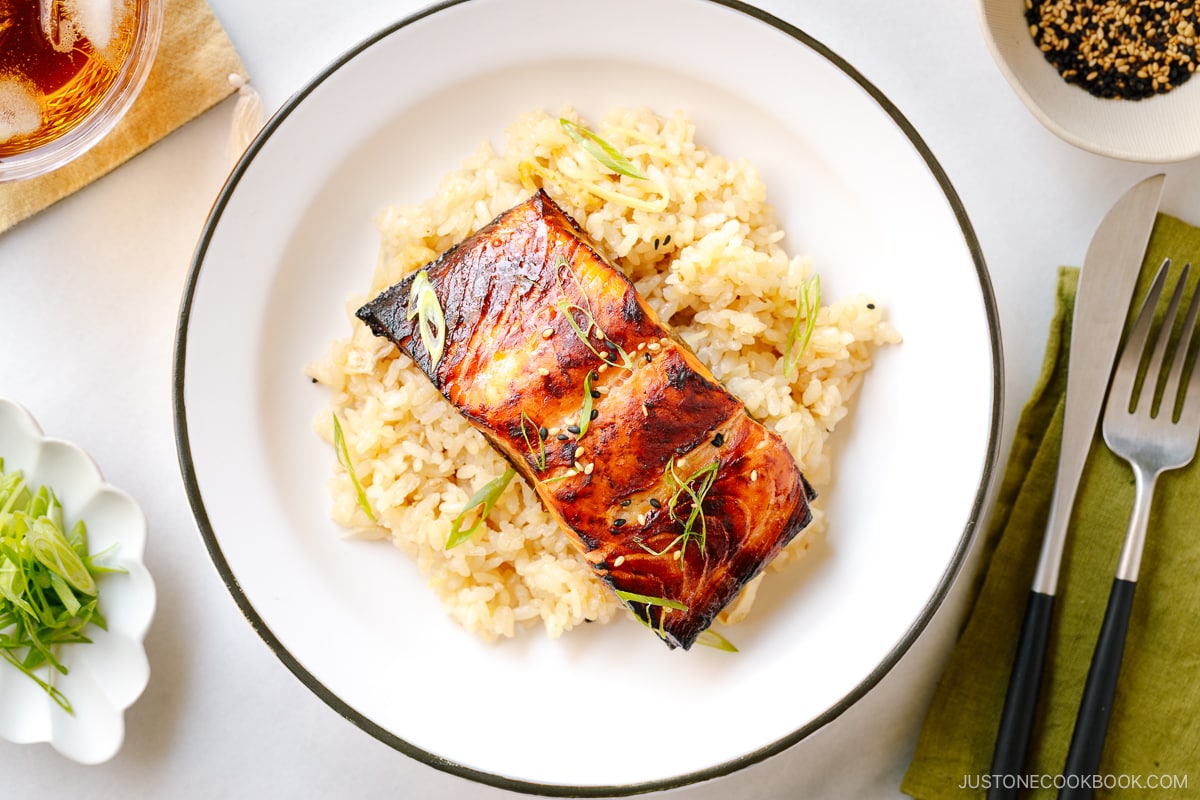
Wish to learn more about Japanese cooking? Sign up for our free newsletter to receive cooking tips & recipe updates! And stay in touch with me on Facebook, Pinterest, YouTube, and Instagram.
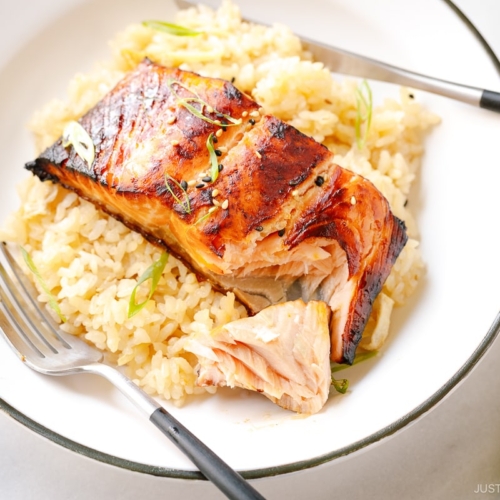
Miso Salmon
Video
Ingredients
- 2 skin-on salmon fillets (¾ lb, 340 g; ideally, less than 1 inch or 2.5 cm thick; 4–6 oz or 113–170 g per fillet)
For the Marinade
- 2 Tbsp miso (use any type of miso; I used Hikari Miso Organic White Miso)
- 1 Tbsp sake
- 1 Tbsp mirin
- 1 Tbsp soy sauce
- ¼ tsp toasted sesame oil
For the Garnish (optional)
- ½ tsp toasted white and black sesame seeds
- 1 green onion/scallion (chopped)
Instructions
- Before You Start: Please note that this recipe requires a marination time of 1–2 hours.
- Gather all the ingredients. Check your 2 skin-on salmon fillets for scales and tiny bones. For bones, run your fingers along the flesh surface and sides to feel for the hard tips of any bones and pull them out with fish boning tweezers. For scales, run your fingers back and forth across the skin to find any scales and scrape them off with the flat edge of a knife.

To Lightly Marinate
- In a large bowl or flat tray, mix the marinade ingredients: 2 Tbsp miso, 1 Tbsp sake, 1 Tbsp mirin, 1 Tbsp soy sauce, and ¼ tsp toasted sesame oil.

- If your salmon is not cut into fillets yet, cut it into individual portions so that they cook faster and evenly. The typical American serving size is 6 oz (170 g). Then, place the salmon in the bowl with the marinade, skin side up.

- Spoon the marinade on top of the salmon, making sure to coat the sides and skin. Cover and keep it in the refrigerator for 1–2 hours for fillets up to 1 inch (2.5 cm) at the thickest part. Marinate for 3 hours for a thicker cut. Tip: This fish is marinated for a short time, unlike Black Cod with Miso. I don’t recommend marinating the salmon overnight, as it will get quite salty.

To Broil (for thin fillets less than 1 inch or 2.5 cm thick)
- Turn on the broiler to High (550ºF/288ºC) with a rack placed in the center position, 9 inches (23 cm) away from the top heating element. Preheat for 5 minutes. Tip: When broiling, you don‘t adjust the oven temperature; instead, you control the distance between the heating element and the surface of the food. It‘s similar to using hotter and cooler zones on your grill. Meanwhile, cut the green onions diagonally into thin slices. Line a baking sheet with aluminum foil (since parchment paper will burn) and spray or brush the oil so the salmon skin won‘t stick.

- Next, take the salmon out of the refrigerator and remove any excess marinade completely; otherwise, the miso may burn during broiling.

- I take the additional step of scraping off the excess marinade with an offset spatula or butter knife (optional). Next, place the salmon pieces skin side down on the prepared baking sheet.

- Broil the salmon until the thickest part of the fillet registers an internal temperature of 125–130°F* (52–54ºC), for roughly 10–13 minutes. You do not need to flip the salmon during broiling. If you prefer it medium rare, you can stop cooking at 120ºF (49ºC). *Please note that the USDA recommends cooking fish to an internal temperature of 145°F (63ºC); however, the residual heat will continue to cook the salmon, resulting in overcooked fish.

To Bake (for thick fillets)
- Preheat the oven to 425°F (218ºC) with a rack placed in the center position. For a convection oven, reduce the cooking temperature by 25ºF (15ºC). Next, take the marinated salmon out of the refrigerator and remove any excess marinade completely from the fish; otherwise, the miso may burn during baking. You can scrape off the marinade with an offset spatula or butter knife if you‘d like.

- Place the salmon pieces skin side down on a baking sheet lined with parchment paper. If you‘re using an oven probe, insert it into the thickest part of the flesh. Tip: If you don‘t have a probe, I highly recommend getting a Thermapen instant-read thermometer.

- Transfer the baking sheet to the oven and attach the probe (if using) to the oven. Bake the salmon until the thickest part of the fillet registers an internal temperature of 125–130°F* (52–54ºC), for roughly 18–20 minutes. You do not need to flip the salmon during baking. If you prefer medium rare, you can stop cooking at 120ºF (49ºC). Tip: My recommended baking time is 5 minutes per ½-inch (1.3-cm) thickness of salmon measured at the thickest part. *Please note that the USDA recommends cooking fish to an internal temperature of 145°F (63ºC); however, the residual heat will continue to cook the salmon, resulting in overcooked fish.

- Take it out from the oven. Test if the salmon is cooking by flaking the flesh. If it flakes easily, it’s cooked through. To char (optional): You can broil the salmon to give it a nice char, if desired. When the salmon is getting close to the desired internal temperature, remove the probe from the salmon and oven. Then, change the oven setting to Broil on High (550ºF/288ºC). Keep the oven rack placed in the center position, 9 inches (23 cm) away from the top heating element. Then, broil the salmon for 3 minutes or until the surface is blistered and browned a bit. Note that the salmon will continue to cook while broiling; therefore, don't wait too long to switch to broil.

To Serve
- Serve the Miso Salmon and top with ½ tsp toasted white and black sesame seeds and 1 green onion/scallion thinly sliced (both toppings are optional). I like to serve this salmon with Ginger Rice. Enjoy!

- Optional: I always discard the marinade (that‘s why I try to use the least amount of marinade), but if you don‘t want to waste it or make too much, you can dilute the marinade with water and cook it for a few minutes. Serve it with the salmon or use it for other dishes.

To Store
- You can store the leftovers in an airtight container and store in the refrigerator for up to 3 days and in the freezer for a month.
Nutrition
Editor’s Note: This post was originally published on September 2, 2014. The post has been updated with revised, clear instructions (still the same recipe) with new step-by-step pictures, final photos, and video on November 17, 2023.
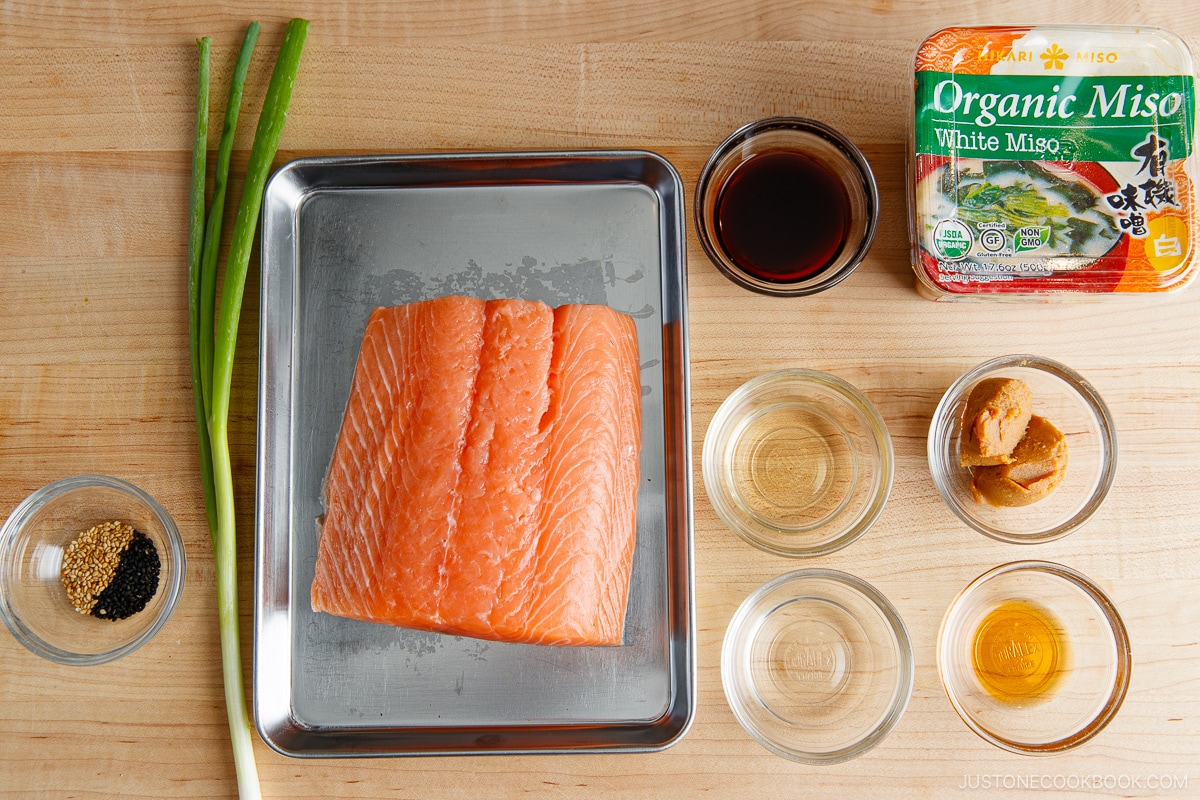
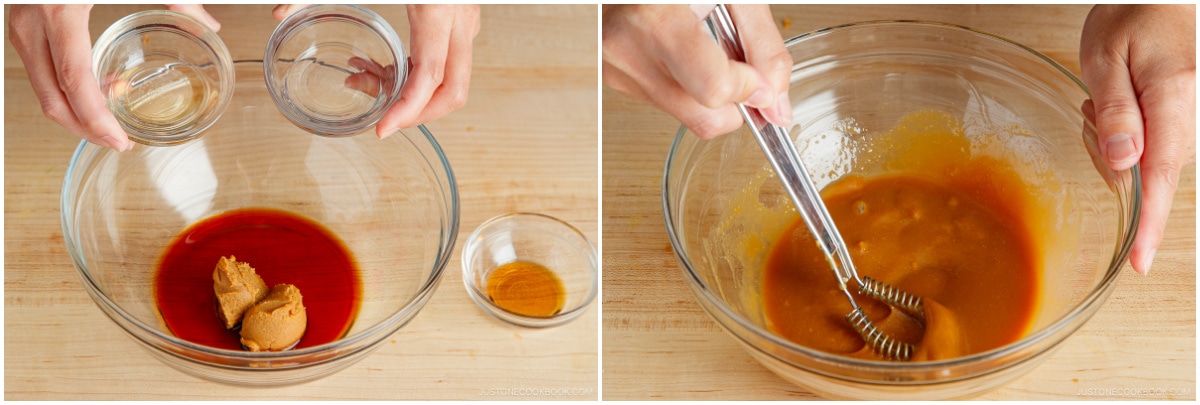
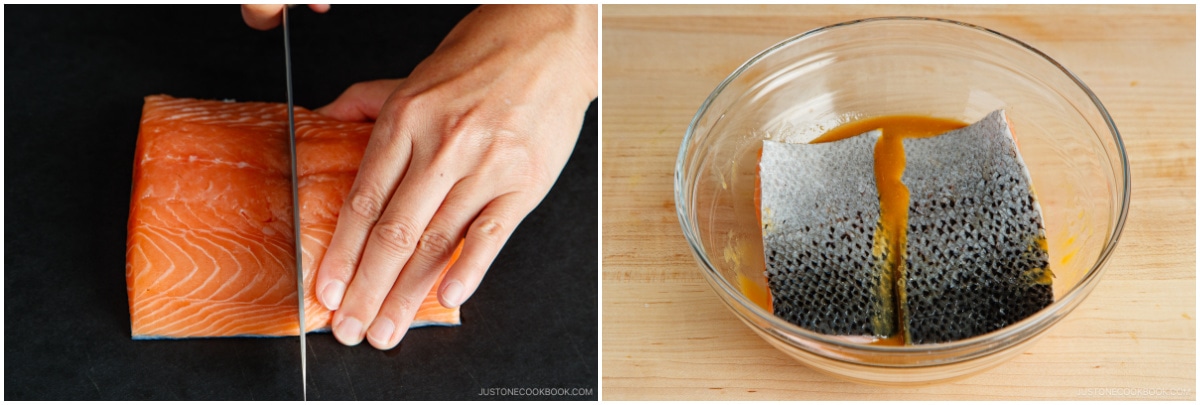
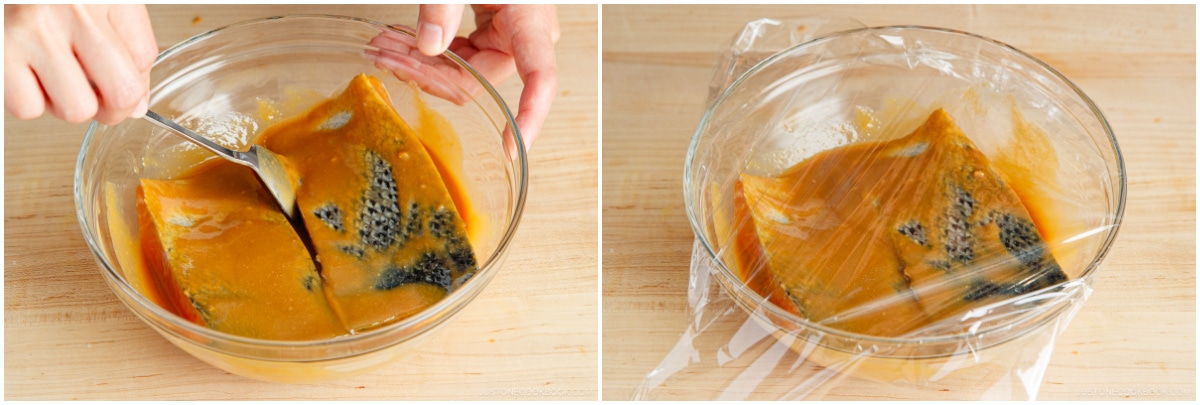
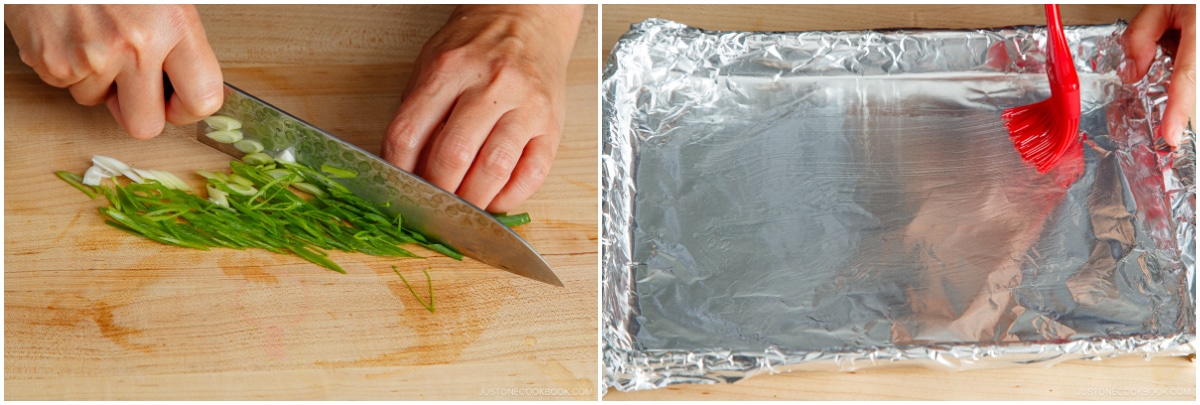
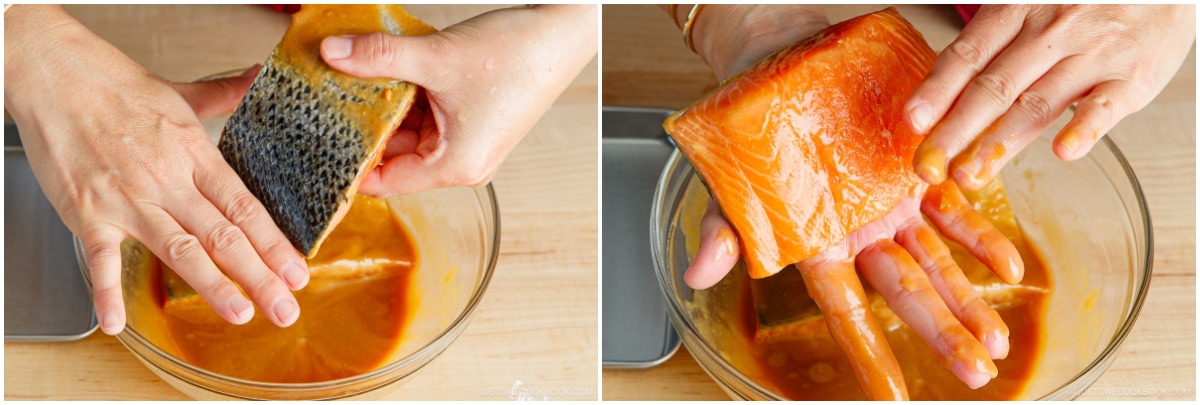
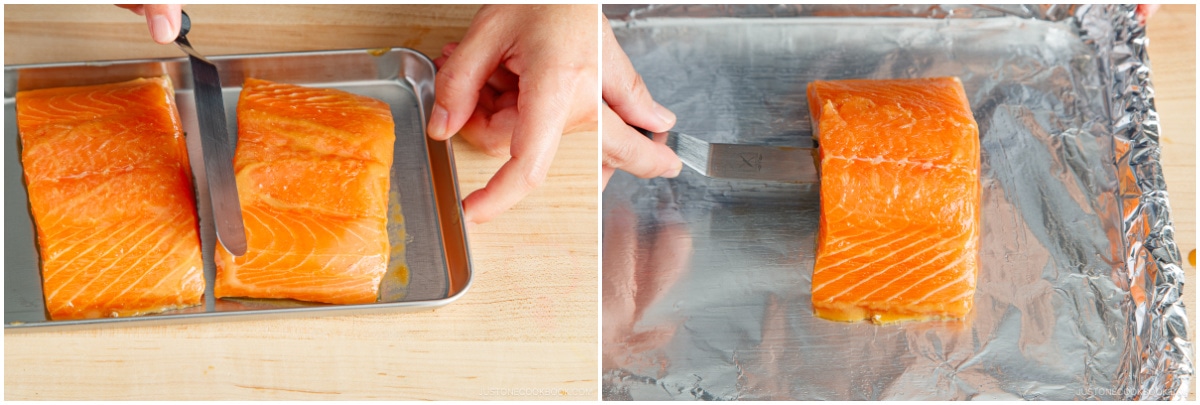
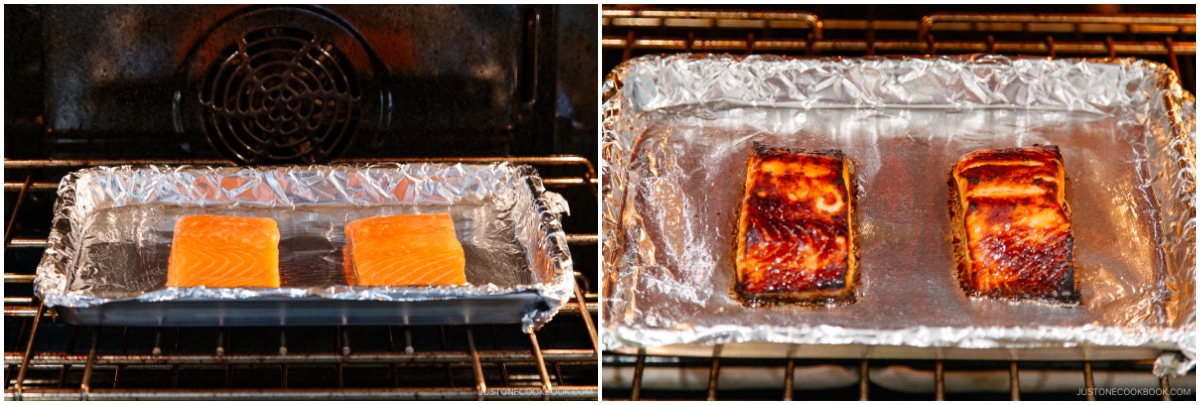
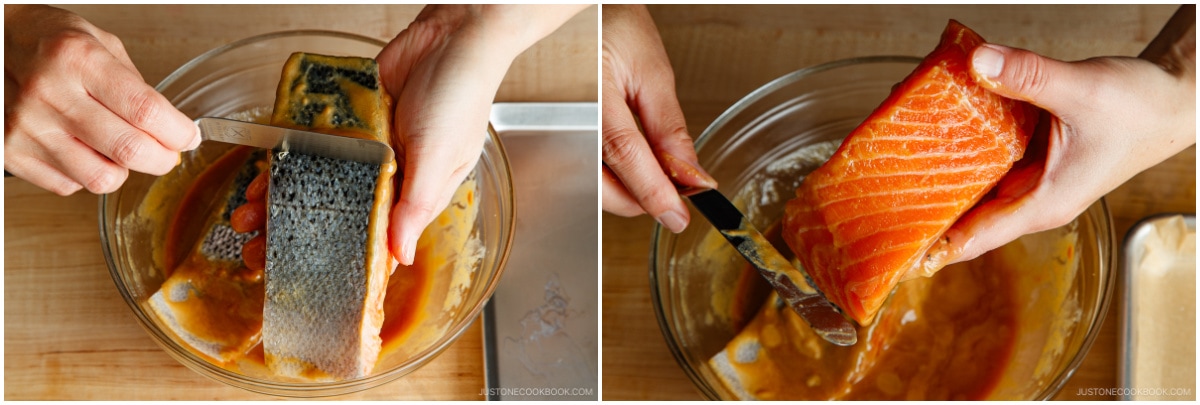
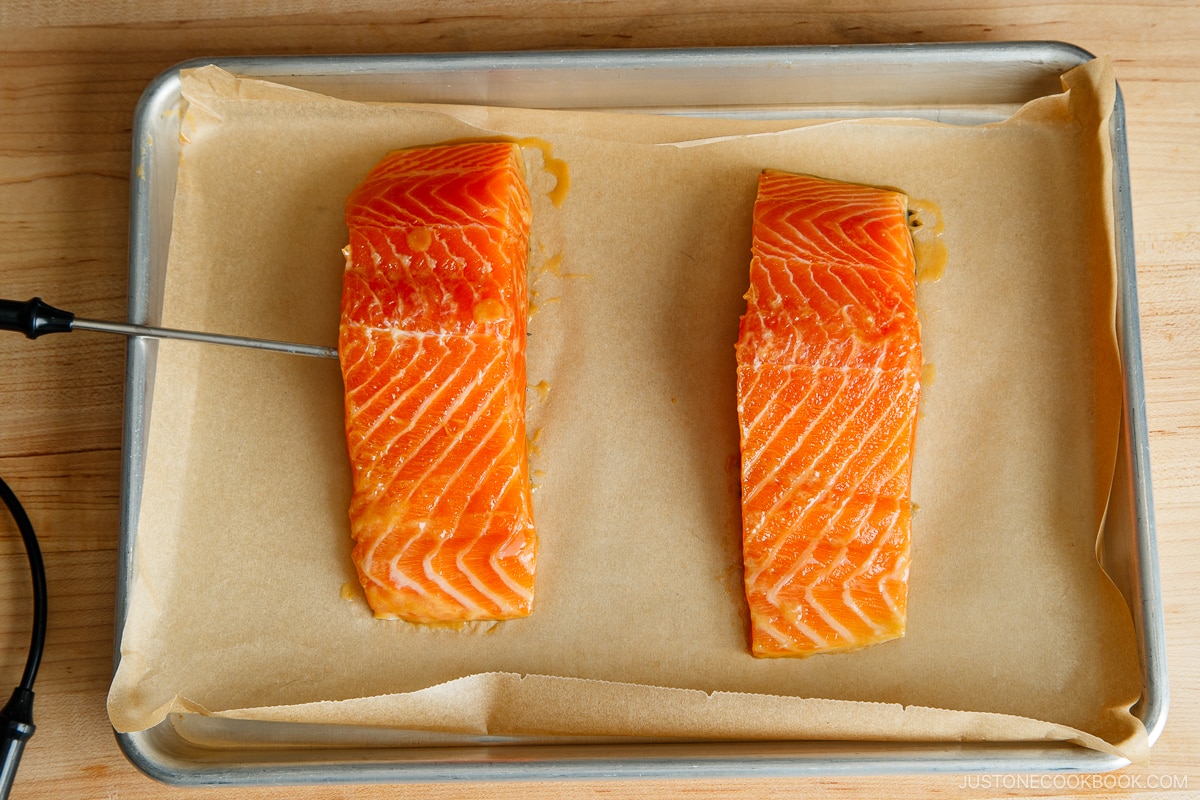
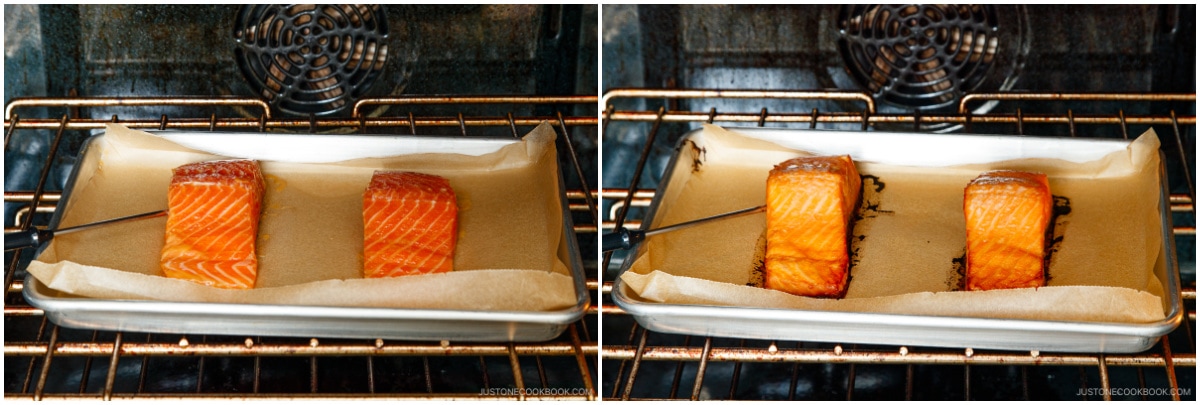
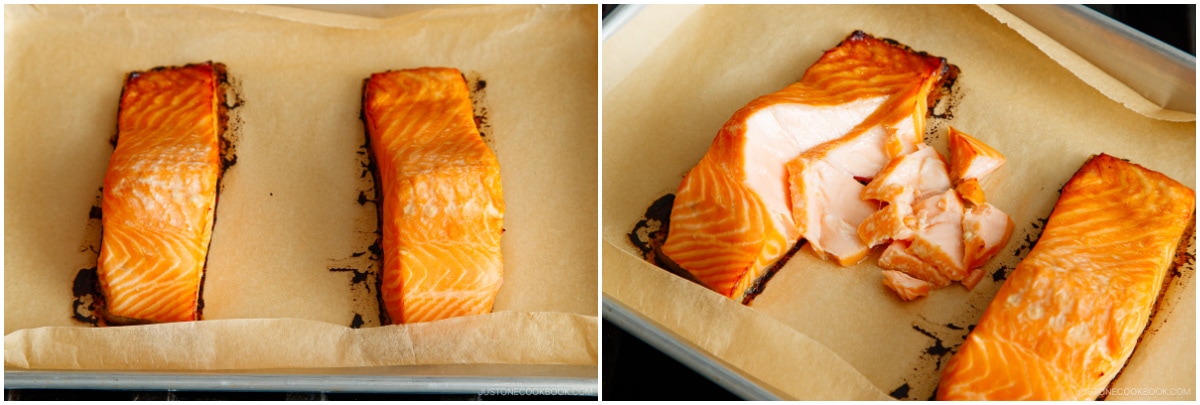
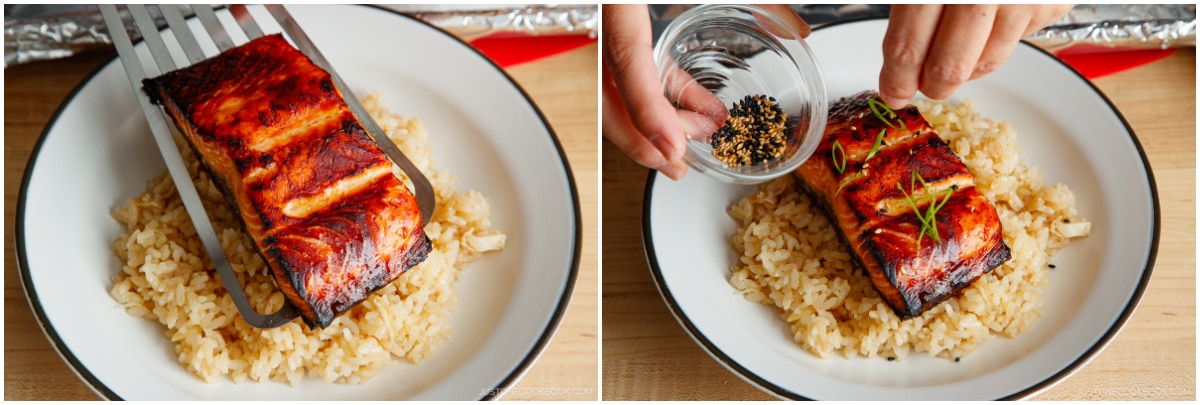
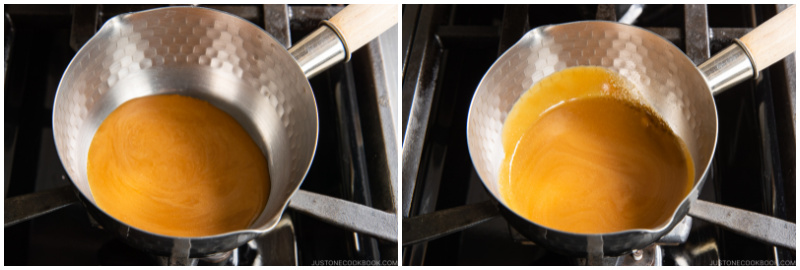










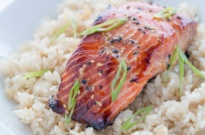
This is one of my favorite recipes! I’ve never been able to get Miso Salmon to taste like it does at my favorite restaurant and this recipe does it…and so easily!
My family likes spicy food so I added 1/2 – 1 tspn of Sriracha sauce to the marinade. It’s yummy without losing the balance of the flavors in your recipe.
I’m so glad my friend recommended your site! Thanks for the great recipe.
Hi Neha! I’m so happy to hear that! Yay! 🙂 Oh yes, you can add Sriracha sauce or any spicy sauce. Please say hello and thanks to your friend for me! 🙂
Just made this with skinless salmon and only had time to marinate it for 30 mins. It was delicious!
Hi May! I’m so glad you liked it! Thanks so much for your kind feedback! 🙂
Thank You for this amazing recipe! Fast as simple as boiling an egg and so delicious. Your site is a real gem!
Hi Dmitry! I’m so glad you liked this recipe! Thank you for trying and giving me kind feedback! 🙂
Oh my goodness, Nami! I made this for our dinner tonight–I served it with the Ginger Rice, along with your Pickled Cucumber recipe that has the La-Yu oil, and an instant suimono. Everything was delicious! Thank you so much for your recipes, they are a wonderful inspiration. 🙂
Hi Jessica! I’m so happy to hear you enjoyed my recipes! What a fantastic meal you made! Thank you for your kind and sweet feedback. 🙂 xo
I made this for dinner tonight and it was so delicious!! It literally melts in your mouth and is so flavorful. And it was super quick and easy to make.
Thank you for another amazing recipe!!
Hi Erica! I’m happy to hear you enjoyed this recipe. Thanks for trying this recipe and for your kind feedback. 🙂
Hi Nami!
I tried out this recipe today using Chinese rice wine (first time cooking with alcohol… O_O) and it turned out beautifully! Thank you for sharing the recipe for the marinade! You were right about the miso being really salty though! It did turn out a bit saltier than what I’m using to tasting for salmon… Thank you for pointing out the dangers of marinating too long too! ^0^ Definitely will marinate for a shorter period of time next time!
Question: What’s the difference between the taste of using white miso vs using awase miso?
Other question: What other salmon recipes do you suggest?
Thank you again for sharing your experiences with cooking! 😀
Hi Cathy! I’m so glad to hear yours came out well! White miso is more mild, but red miso has stronger taste. Awase miso which is the combination of white and red miso are somewhere between. It also depends on how much white and red miso you use (or the brand of awase miso uses). Have you tried my Salted Salmon recipe? It’s our favorite and don’t forget to make fried rice with the leftover! 🙂 Here’s the link:
https://www.justonecookbook.com/recipes/how-to-cook-salmon-salted-salmon/
This has become a staple in our house, to the point where we eat it at least once a week! So simple, and so yummy. We tried cooking it without the skin last night but it fell apart, so I’d definitely recommend leaving the skin on. Thanks for another wonderful recipe Nami. I’m a big fan of your work. 🙂
Hi Ellie! Yay! So happy to hear you enjoy this dish as much as we do! Yeah the skin is actually pretty important to keep it together. Thanks for your kind feedback and for following my blog! xo
Is there something else that can be subbed in for the sake?
Hi Lindsay! Dry sherry or Chinese rice wine would be good substitute. Otherwise, you can omit – but the marinade is lacking some liquid so add tiny bit of water to dilute. Hope this helps!
Details about sake here: https://www.justonecookbook.com/pantry/sake/
Hi Nami. I’m from Malaysia. I really love Japanese foods as they are healthy and tasty. However, some recipes here use sake and i can’t use it since i’m a Muslim. Is it okay if i don’t use it or is there anyway i can replace it with something else?
Hi Lynn! It will not be the same without them, but you can try with water + sugar. You will need some liquid to dilute the sauce as well as sweetness that you’ll be missing from mirin. It shouldn’t be too different as you are not using completely different ingredient. 🙂 Hope this helps!
Healthy and delicious. I’ve been following your blog since 1 year and I love it. The photos are very good, I have learnt few points from your blog and implemented them on my food blog.
Hi Dr. Sindhoora! Thank you for following my blog and for your kind compliment!
Hey Nami! I tried making the miso salmon… but the salmon came out really “fishy” (the bad taste that leaves you cringing). Is there anything I can do to help with that? I’m already buying nice Atlantic salmon (I’m from Canada, so fish is usually pretty good).
Hi Gin! The only thing I can think of is that this batch of fish wasn’t fresh. Fresh salmon shouldn’t leave you “fishy” after taste. Assuming that miso and other ingredients were in good condition, I believe there is no reason why the salmon comes out “fishy” unless the fish was not good. You eat salmon often and never thought it’s fishy right? If the “fishy” tastes bother you in general, marinate the salmon in a little bit of sake for 10 minutes help remove the fishy (or gamey if its’ meat) smell. Hope this helps. 🙂
Thanks! 🙂 I’ll definitely try it 🙂
Hi just wanted to say I love this recipe! It was so easy and delicious that my boyfriend and I made it twice in one weekend.
I’m so happy to have found your blog, too! I love Japanese food and have always wanted to learn to make it myself. Your recipes are very easy to follow, and now I’m brimming with ideas for what to do with the leftover miso from the marinade!
Hi Cynthia! So glad you stopped by and thank you so much for making this recipe! I’m happy to hear you you cooked twice in a week! Yay! I hope you find some other recipes from my blog that you would like to challenge. Let me know if you have any question!
By the way, speaking of marinade… it’s not recommended to re-use the marinade that the raw food was in it. The bacteria etc may not be visible but it might grow in the marinade. Therefore, it should be cooked and cool down before using as marinade. Hope that helps! 🙂
Thanks, I’ll definitely be in touch if I have any questions!
Regarding the marinade, that was poor phrasing on my part. I meant that I was excited to use the leftover miso paste, not the miso marinade. Don’t worry, we disposed of the marinade after we cooked the fish and didn’t re-use it at all!
Thanks again 🙂
Haha! I’m glad you didn’t re-use the marinade. 😀
Miso recipes should be included in this list. Hope you find something you like in this list. Enjoy! 🙂
https://www.justonecookbook.com/tags/miso/
Hi Nami,
Just want to ask if we can fry the salmon as i dont have an oven at home. If frying, should it be done differently?
Hi Linh! Cook the salmon skin-side down. If the salmon is firm enough you should be able to flip to brown the other side just a little bit to brown. If your salmon is a thick piece, you may want to cover it with a lid. Oh and you still need to remove the miso marinade well from the fish so your salmon won’t get burnt. Hope that helps! 🙂
Hey, Nami-san! This looks delicious! I was just wondering if you could use salmon without the skin and if I could also use ‘awase miso’ instead of ‘shiro miso’. Thanks!
Hi Megumi-san! You could, but be gentle when handling as it might fall apart easily without the skin (after cooked). And yes, white or any miso is okay. Hope you enjoy!
Looks delicious as usual….Great looking salmon (wild?)….Love your utensils…where did you get great mixing utensil? Welcome home and looking forward to recipes now that children are back in school…:)
Hi Lyn! We used the wild king salmon (it was expensive but very good!). Here’s the link for the whisk: http://goo.gl/1o4UBi – I got one on Amazon. 🙂